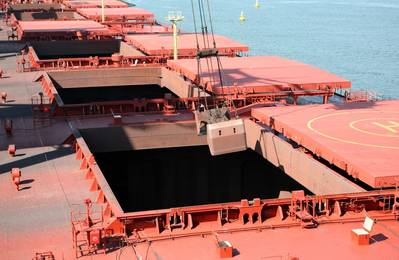The UK P&I Club’s Loss Prevention Department, in conjunction with the IMCS Training Academy, advises on the importance of hatch cover maintenance: “Whether a ship’s hatch covers are weathertight is a seemingly simple question that should have a “Yes” or “No” answer. However, coming to the right conclusion is not as easy as may initially be assumed, requiring an understanding of hatch covers, their operation and industry requirements.
“Ensuring hatch covers are well maintained, and that crew are trained and experienced in their usage greatly reduces the number of claims relating to water damaged cargo. Both claims analysis and third party inspections indicate that in many cases hatch cover maintenance is not considered to be a priority, and when maintenance is carried out, it is often not done in line with the manufacturers’ guidelines and good industry practice.
“Good maintenance starts with good inspections; this requires proper planning, development of ship/hatch specific checklists, and educating shipboard staff. Inspections should be carried out against the manual specifications, and not against the crew’s own criteria or opinions. If inspections are carried out in a systematic way, at frequent intervals and are well documented, possible problems will be identified at an early stage allowing for cheaper and better repairs.
“Necessary maintenance and repairs are often only carried out after a ship has entered the loading port and fails a hatch cover tightness test. This can mean that maintenance has to be organised quickly, in an unplanned manner, and not always with the proper spare parts. This approach generally requires the crew to work long hours, often overnight, and carry out temporary repairs that are merely focussed on passing the tightness test as soon as possible without giving proper regard to the quality of repairs carried out.
“Whenever a substantial claim is filed against the ship, surveyors will be instructed to attend on board and carry out an investigation into the cause of the damage. This generally reveals that in the load port, quick or improper temporary repairs were carried out which were insufficient to withstand the rigours of an ocean voyage. Quick or improper repairs typically follow inadequate due diligence.
“A good maintenance strategy also includes record keeping. Maintenance related documents, such as test reports, work orders, spare part orders, work schedules, hatch manuals and drawings, on board checklists and inspection reports should be properly kept and filed. Should a claim for wetting damage be filed against the ship, a well prepared maintenance file will be of great value in defending the owner’s interest and proving that due diligence was exercised.
“Well maintained hatch covers can make the difference between a profitable or loss making voyage. Claims resulting from wetting damage due to leaking hatch covers still contribute a huge part of the overall loss figures on dry cargo ships, and can weigh heavily on the owner’s operational budget and profit. More importantly, improper usage and poor maintenance of hatch covers can cause tragic injuries among crew, which can be avoided through the provision of adequate training and procedures.”














